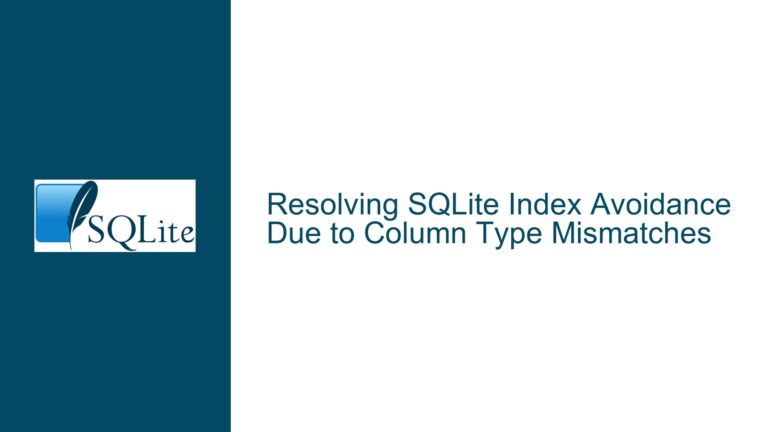and Mitigating False Positives in SQLite Bloom Filters
Bloom Filter Mechanics and Their Role in SQLite Query Optimization
Bloom filters are probabilistic data structures used in SQLite to optimize query performance by reducing the number of expensive B-tree lookups. They work by hashing elements and setting bits in a bit array based on the hash results. When a query is executed, the Bloom filter is consulted to determine whether a B-tree lookup is necessary. If the Bloom filter indicates that an element is not present, the lookup is skipped, saving CPU cycles. However, if the Bloom filter suggests that the element might be present, a full B-tree lookup is performed to confirm its presence.
The key characteristic of Bloom filters is that they can produce false positives but never false negatives. A false positive occurs when the Bloom filter incorrectly indicates that an element is present, leading to an unnecessary B-tree lookup. A false negative, on the other hand, occurs when the Bloom filter incorrectly indicates that an element is not present, causing the query to skip a necessary B-tree lookup. While false negatives are harmless in terms of query correctness, they do result in wasted CPU cycles. False positives, however, can lead to incorrect query results if not handled properly.
The Implications of False Positives in Bloom Filters
False positives in Bloom filters arise due to hash collisions, where different elements produce the same hash value. When a hash collision occurs, the Bloom filter may incorrectly indicate that an element is present, even though it is not. This can lead to the avoidance of a B-tree lookup that would have yielded a match, resulting in incorrect query results.
The comment in the Bloom filter implementation highlights this issue, stating that false positives can lead to incorrect answers if the query takes a jump when it should fall through. This means that if the Bloom filter incorrectly indicates that an element is present, the query may skip a necessary B-tree lookup, leading to incorrect results. The comment also notes that false negatives are harmless, as they only result in additional CPU cycles being used.
The challenge, therefore, is to ensure that false positives do not lead to incorrect query results. This requires a mechanism to handle cases where the Bloom filter incorrectly indicates that an element is present, ensuring that the query still yields the correct answer.
Strategies for Handling False Positives in SQLite Bloom Filters
To mitigate the impact of false positives in SQLite Bloom filters, several strategies can be employed. These strategies aim to ensure that even if the Bloom filter incorrectly indicates that an element is present, the query still yields the correct result.
One approach is to use a secondary verification step when the Bloom filter indicates that an element is present. This involves performing a full B-tree lookup to confirm the presence of the element, even if the Bloom filter suggests that it is present. While this approach eliminates the risk of incorrect results due to false positives, it also negates the performance benefits of using the Bloom filter in the first place.
Another approach is to design the Bloom filter in such a way that the probability of false positives is minimized. This can be achieved by increasing the size of the Bloom filter or using multiple hash functions. However, this approach increases the memory footprint of the Bloom filter and may not be feasible in all scenarios.
A more practical approach is to design the query logic in such a way that false positives do not lead to incorrect results. This can be achieved by ensuring that the query logic is robust enough to handle cases where the Bloom filter incorrectly indicates that an element is present. For example, the query logic could be designed to fall through to a full B-tree lookup if the Bloom filter indicates that an element is present, but the result of the lookup does not match the expected value.
In addition to these strategies, it is also important to consider the trade-offs involved in using Bloom filters. While they can significantly improve query performance by reducing the number of B-tree lookups, they also introduce the risk of false positives. Therefore, it is important to carefully evaluate the impact of false positives on query correctness and performance when using Bloom filters in SQLite.
Conclusion
False positives in SQLite Bloom filters can lead to incorrect query results if not handled properly. While false negatives are harmless, false positives can cause the query to skip necessary B-tree lookups, leading to incorrect results. To mitigate the impact of false positives, it is important to employ strategies such as secondary verification steps, minimizing the probability of false positives, and designing robust query logic. By carefully considering the trade-offs involved in using Bloom filters, it is possible to achieve significant performance improvements without compromising query correctness.






